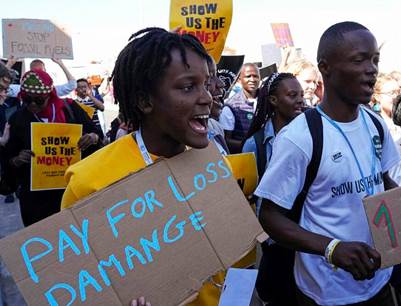Description

Copyright infringement not intended
Context: The Sharm el-Sheikh climate meeting will probably always be remembered for its decision to set up a loss and damage fund. This decision has earned it a place among the major milestones in the global response to climate change. But on most other parameters, the COP27 — proved to be an underachiever.
Details:
Mitigation
- Going into the conference, it was expected that COP27 would respond to the growing urgency for greater emission cuts. Most scientific estimates now suggest that the 1.5 degree Celsius targetfor temperature rise is likely to be breached within a decade.
- With current efforts to reduce emissions, the world is headed to a temperature rise of about 3 degree Celsius from pre-industrial times by the end of this century.
- There were different ways in which COP27 was expected to respond to this. One of the ideas, floated by the European Union, was to ask every country to strengthen their respective climate actions every year from now to 2030, a radical suggestion that was unlikely to have met with approval from most countries. As of now, the countries have to upgrade their climate actions every five years. The latest upgrade was just this year.
- Another idea was to call for a phase-down of all fossil fuel use. This was unlikely to have done much to reduce emissions in the short term, but would still have been meaningful towards the larger objective of curbing the use of the main causes of global warming.
- The idea, proposed by India, was initially expected to be opposed by developed countries, especially since their dependence on oil and gas has increased in the last one year. However, after initial hesitation, both the EU as well as the United States backed the proposal. The opposition came from within the ranks of the developing countries, especially from the oil-producing Gulf nations. The matter was not pushed.
- The least that was hoped for on this front was an inclusion of a stronger mention of the goal of pursuing the 1.5 degree Celsius target. It would have been little more than a statement of intent. But even that was not agreeable to all.
- The only decision in this regard was to continue the discussions on a work programme set up last year to “urgently” scale up mitigation action. COP27 decided that two global dialogues would be held each year as part of this work programme.
Adaptation
- Most of the conversation on climate actions is focused on mitigation efforts. Developing countries, who are more vulnerable to the impacts of climate change, have often argued that adaptation is not given sufficient attention.
- At the Glasgow climate meeting, an effort was initiated to define global goals on adaptation, just as the 2 degree or 1.5 degree Celsius targets serve as the global goal for mitigation.
- Nothing much was delivered on this track, except for expressing support to the Glasgow-Sharm el-Sheikh work programme that is scheduled to finish its work next year.
- Developing countries have been demanding that at least half of climate finance should be directed towards adaptation projects. Some countries, including the United States, did promise some money, but it wasn’t more than a trickle.
- An important initiative on adaptation came from the UN Secretary General, who unveiled plans of the World Meteorological Organisation (WMO) to set up early warning systemsin areas that do not have them.

Finance
- The biggest disappointment, not surprisingly, came in matters related to money. The developed countries have not yet delivered on their promise to mobilise USD 100 billion every year, something that should have happened in 2020.
- All that the COP27 final agreement did about this was to “express serious concern”.
- Interestingly, the COP27 agreement, for the first time, quantified the financial needs for climate action.
- It said about USD 4 trillion had to be invested in the renewable energy sector every year till 2030 if the 2050 net zero target was to be achieved. Additionally, at least USD 4-6 trillion was required every year for global transformation to a low-carbon economy. About USD 5.9 trillion was needed by the developing countries in the pre-2030 period, just to implement their climate action plans.
- The developed countries have said they will ensure the USD 100 billion flow from 2023. A parallel discussion is going on to scale up this amount from 2025.
- Additionally, the COP27 agreement has urged international financial institutions to simplify their procedures and priorities, so that it is easier for developing countries to access money for climate actions.

https://indianexpress.com/article/explained/explained-climate/cop27-climate-summit-highlights-loss-and-damage-fund-india-8284047/











